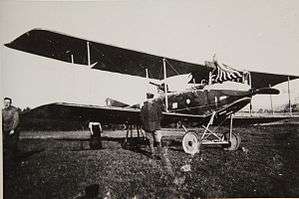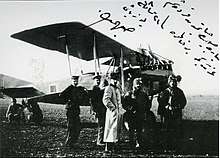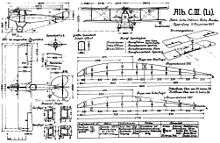Albatros C.III
The Albatros C.III was a German two-seat general-purpose biplane of World War I, built by Albatros Flugzeugwerke. The C.III was a refined version of the successful Albatros C.I and was eventually produced in greater numbers than any other C-type Albatros.
| Albatros C.III | |
|---|---|
 | |
| Role | General purpose |
| Manufacturer | Albatros Flugzeugwerke DAR |
| Introduction | 1915 |
| Primary users | Luftstreitkräfte Polish Air Force Finnish Air Force Bulgarian Air Force Lithuanian Air Force |
Use
The C.III was used in a wide variety of roles including observation, photo-reconnaissance, light bombing and bomber escort. First twelve aircraft went to the front in December 1915.[1] The biggest number was available on the front in August 1916 – 354.[2] They were mostly withdrawn from frontline service by mid-1917, although the production continued for training.[1] Orders for 2271 aircraft in total are known.[2]
Eighteen C.IIIs were delivered in August 1916 to Bulgaria. They were destroyed in 1920 in accordance with the Treaty of Neuilly-sur-Seine. According to other sources, 26 Albatros C.III were delivered to Bulgaria, including eight trainers.[3]
Polish Air Force operated 15 Albatros C.III in 1918-1920 during Polish-Soviet War.[4]
Construction
Like the Albatros C.I, the C.III was a popular aircraft with rugged construction and viceless handling. The most prominent difference between the two was the revised vertical stabilizer. The C.III had a lower, rounded tail compared to the large, triangular tail of the C.I, which, combined with smaller weight, gave the C.III greater agility. The power plant was either a 110 kW (150 hp) Benz Bz. III or a 120 kW (160 hp) Mercedes D.III inline engine and, like numerous other two-seaters used during the war (such as the British Royal Aircraft Factory R.E.8) the cylinder head and exhaust manifold protruded above the front fuselage, limiting the pilot's forward visibility.
The observer, who occupied the rear cockpit, was armed with a single 7.92 mm (0.312 in) Parabellum MG14 machine gun. C.III aircraft were typically fitted with a gun synchronizer and a single forward-firing 7.92 mm (0.312 in) LMG 08/15 machine gun. The C.III could also carry a bomb load of up to 90 kg (200 lb)[4] in four vertical tubes in the fuselage or external racks.[5]
Between 1926 and 1927, two Mercedes D.III engined copies were built from saved parts and components of the destroyed aircraft by Bulgarian state aircraft workshops DAR as the DAR 2 for use as trainers.[6][7] According to D. Nedialkov, twelve DAR-2 were built (at least nine are confirmed by a photograph).[8]
Operators

- Bulgarian Air Force (including DAR-2)
- Polish Air Force (15 used)[4]
- Ottoman Air Force (nos AK 8 to AK 41)[9]
- Austro-Hungarian Air Force
Variants
Data from[12]
- C.VI
- (L 16) about 300 mm (11.8 in) shorter and 20 kg (44 lb), with strengthened engine bearers to take a 180 hp (134 kW) Argus As III six-cylinder inline. Some 4% faster. Limited production.[13]
.jpg)
- W.2
- Seaplane variant with twin floats, modified Mercedes D.II installation, revised cabane strut and a much larger fin. Parabellum MG14 machine gun in observer's cockpit. One only, delivered June 1916.
Specifications (C.III)

Data from [14]
General characteristics
- Crew: 2
- Length: 7.9 m (25 ft 11 in)
- Wingspan: 11.7 m (38 ft 5 in)
- Height: 3.2 m (10 ft 6 in)
- Wing area: 36.91 m2 (397.3 sq ft) [15]
- Empty weight: 830 kg (1,830 lb)
- Gross weight: 1,343 kg (2,961 lb)
- Powerplant: 1 × Argus As.III 6-cylinder water-cooled in-line piston engine, 130 kW (180 hp)
- Propellers: 2-bladed propeller
Performance
- Maximum speed: 145 km/h (90 mph, 78 kn)
- Endurance: 4 hours 30 minutes
- Service ceiling: 3,350 m (10,990 ft) [15]
- Time to altitude: 3,000 m (9,800 ft) in 35 minutes
Armament
- Guns: 1 × 7.92 mm (0.312 in) Parabellum MG14 machine gun in observer's cockpit and 1 × fixed forward-firing 7.92 mm (0.312 in) LMG 08/15 in the nose.[15]
- Bombs: up to 200 lb (91 kg) of bombs[15]
See also
Related development
Aircraft of comparable role, configuration and era
Related lists
References
![]()
- Grosz (1989), p.3
- Grosz (1989), p.28
- Nedialkov, Dimitar. "Air Power of the Kingdom of Bulgaria. Part II", Fark OOD, Sofia, 2001. pp.22-23, 28-29. (bilingual: Bulgarian/English)
- Morgała, Andrzej (1997). Samoloty wojskowe w Polsce 1918-1924 [Military aircraft in Poland 1918-1924] (in Polish). Warsaw: Lampart. pp. 18–20. ISBN 83-86776-34-X.
- Grosz (1989), p.11,13,18
- Bernád 2001, pp. 24–25.
- Y. Milanov: Aviation in Bulgaria in the Wars from 1912 to 1945, Vol.I. Sveti Gueorgui Pobedonosetz, Sofia, 1995 (in Bulgarian)
- Nedialkov, Dimitar. "Air Power of the Kingdom of Bulgaria. Part III", Fark OOD, Sofia, 2001. pp.4, 20-21, 59. (bilingual: Bulgarian/English)
- Grosz (1989), p.29
- Grosz (1989), p.7
- Grosz (1989), p.12
- Gray, Peter; Thetford, Owen (1970). German Aircraft of the First World War. London: Putnam. p. 256. ISBN 0-85177-809-7.
- Kroschel, Gunter; Stutzer, Helmut (1994). Die deutschen Militärflugzeuge 1919-1934 : mit 143 Vierseitenrissen im Massstab 1:144 (Lizenzausg ed.). Weltbild. pp. 26, 68. ISBN 3893506934.
- Gray, Peter; Thetford, Owen (1970). German Aircraft of the First World War (2nd ed.). London: Putnam. p. 256. ISBN 0-370-00103-6.
- Sharpe, Michael (2000). Biplanes, triplanes, and seaplanes. London: Friedman/Fairfax. p. 28. ISBN 1-58663-300-7.
Further reading
- Bernád, Dénes. "Balkan Birds: Thirty Five Years of Bulgarian Aircraft Production". Air Enthusiast. Stamford, Lincs, UK: Key Publishing (94, July/August 2001): 18–30. ISSN 0143-5450.
- Grosz, Peter M. (1989). Albatros C. III. Berkhamsted: Albatros Productions. ISBN 0-948414-17-0.